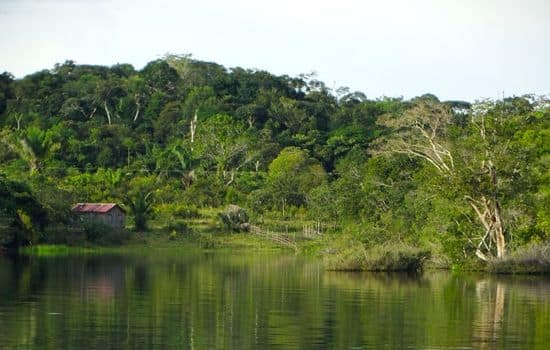Advertisements
Today I'm going to talk about the curiosities of the Amazon region and its magnificent forest.
The forest is at risk and its biodiversity continues to decrease due to human action.
Advertisements
For everyone to get to know this region with such a vast ecosystem, which enchants everyone who sees it.
SEE ALSO
Advertisements
THE FASCINATING WORLD OF SHARKS
WHAT YOU NEED TO KNOW BEFORE GETTING A GUINEA PIG
Below you will find a list of interesting facts you need to know about this beautiful and rich region.
There are nine countries and nine states
The Amazon is the largest tropical forest in the world and occupies nine countries: Bolivia, Brazil, Colombia, Ecuador, French Guiana, Paraguay, Peru, Suriname and Venezuela.
In Brazil, the biome occupies nine states: Acre, Amapá, Amazonas, Pará, Roraima, Rondônia, Tocantins and part of Maranhão and Mato Grosso.
It is equivalent to almost half of the national territory.
Largest aquatic plant in the world
The Victoria Regia is typical of the region, standing out for being one of the largest aquatic plants in the world.
To give you an idea, its leaf can reach a diameter of up to 33 centimeters.
If the Amazon were a country
The state has 5,500 square kilometers, if it were a country, it would be the seventh largest in the world, behind Australia (7,692 km²) and ahead of India (around 3 thousand km²).
Flying rivers
The Amazon region has high air humidity, which is directly related to the number of existing trees.
It has six thousand known species, some of which have roots that can penetrate around 30 meters into the soil, thus extracting all the necessary water.
The trunks and branches are like pipes carrying this water to the flowers, which perspire and release all this moisture into the air.
A total of 500 liters of water are pumped into the air from each tree each day.
Therefore, 20 billion tons of water are released into the air every day from the Amazon.
And part of this water returns to the ground in the form of rain and another part turns into “flying rivers”, represented by large clouds that fly over the region.
Cools the planet
Contrary to popular knowledge about the Amazon, it contributes 20% of oxygen to the atmosphere.
In fact, it contributes approximately 20% of the oxygen produced by photosynthesis on the planet.
In addition to making a significant contribution to removing carbon dioxide from the atmosphere.
However, it is not a pair of lungs, but rather a giant air conditioner that cools the planet.
Floods
When the Amazon tributaries reach their lowest levels, torrential rains begin to fall with brutal force.
In a short time the forest is submerged, reaching almost 30 meters of flooding in the jungle, enough to cover a ten-story building.
Underwater Forests
The number of underwater forests is increasing in the Amazon region, providing huge plantations of seaweed.
Algae help combat climate change as they are effective at storing carbon.
In addition to helping to reduce acidification, deoxygenation and other marine impacts of global warming.
One plant species per day
The Brazilian Amazon exudes so much life that explorers have discovered new species of plants or animals almost daily.
A two-year study of the newly discovered species, conducted by the World Wildlife Fund, WWF concluded this.
Largest volume of water on the planet
The Amazon River, with an average annual flow of 176 million liters of water per second, is the largest in terms of water volume in the world.
At its mouth, production is 100 million liters of water per second.
Typical Amazonian fruit
The Guaraná fruit, discovered in 1821 by Humboldt among indigenous tribes in the municipality now called Maués, is typical of the region.
The Indians considered guarana sacred and used the fruit paste as medicine.
Largest mangrove
The Amazon coastal region has the largest number of mangroves in Brazil.
Approximately 80% of the country's mangroves are found there and are home to a huge deposition of nutrient-rich muddy material.
underground river
An underground river beneath the Amazon River was discovered by scientists, named Hamza in honor of researcher Valya Hamza.
It is located four thousand meters deep, with a total length of six thousand kilometers and runs in the same direction as the Amazon River.
Super fish
The largest number of electric fish are found in this region.
They produce discharges that vary between 300 and 1,500 volts, the species reaches up to three meters and weighs 30 kilos.
Giant wave at the mouth of the Amazon River
Pororoca It is a natural phenomenon that occurs when sea water meets a river.
This meeting forms a wave, which can reach up to 4 meters in height, advancing 50 kilometers into the Amazon River.
Indigenous Population
Indigenous tribes are the greatest symbol of the Amazon, present in the region long before the colonization of Brazil.
The largest groups of Indians in the region are the Guaranis, Xerentes, Amawákas, Anambés, Kambebas and the Aruás.
Fish food
One hectare of flooded forest produces up to 20 tons of seeds and fruits annually, food for many fish.
When the forest is deforested, fish are directly affected.
Dolphins can change from gray to pink in minutes
To regulate the temperature of the dolphins, the blood flows faster where the color change occurs.

Mercury contaminates the waters of the Amazon
Mercury is used to separate gold from sediment, used by miners in the region.
Causing water contamination and serious deforestation processes.
Important!
There are many conservation and protection projects in the Amazon region, I recommend that you learn about one of these projects.
Because it is important to our lives, the ecosystem influences the planet's climate.
The right thing to do is to take care of nature, starting with our surroundings, such as not throwing rubbish on the ground or in rivers and recycling plastic.
If we all did this, we would change the world.
